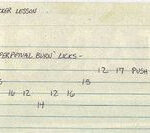For guitar enthusiasts, the allure of iconic guitars goes beyond mere instruments; they are symbols of musical innovation, cultural shifts, and the indelible bond between artists and their craft. Throughout history, certain guitars have transcended their material form to become legends themselves, intrinsically linked to the musicians who wielded them. These Famous Guitars, often seen in the hands of our musical heroes, possess a unique aura, telling stories of groundbreaking performances, revolutionary sounds, and the very soul of rock and roll. Some instruments, like the celebrated Gibson ‘Greeny’ Les Paul, boast a lineage as rich and complex as the music they’ve inspired, passing through the hands of multiple iconic players.
This article delves into the stories of some of the most famous, influential, and instantly recognizable guitars in the world, and the rockstar owners who made them immortal. We’ll explore what makes each guitar special, its unique characteristics, and the music it helped create, accompanied by videos showcasing these legendary pairings in action. Prepare to discover if your personal favorite made the list of these truly famous guitars.
 Eddie Van Halen and his iconic Frankenstein guitar
Eddie Van Halen and his iconic Frankenstein guitar
The Gibson ‘Greeny’ Les Paul: A Triad of Guitar Gods – Green, Moore, and Hammett
Arguably one of the most storied Gibson Les Pauls ever created, ‘Greeny’ is a 1959 Gibson Les Paul Standard, distinguished by its subtly faded Sunburst finish and an extraordinary history. Its initial claim to fame arose with Peter Green of Fleetwood Mac, a guitarist revered for his emotive playing and distinctive tone. Green’s sound, in part attributed to a unique wiring anomaly or modification (a subject of ongoing debate among guitar aficionados), imbued the typically powerful Les Paul sound with a more nuanced, almost vocal-like quality, highly sought after by tone purists.
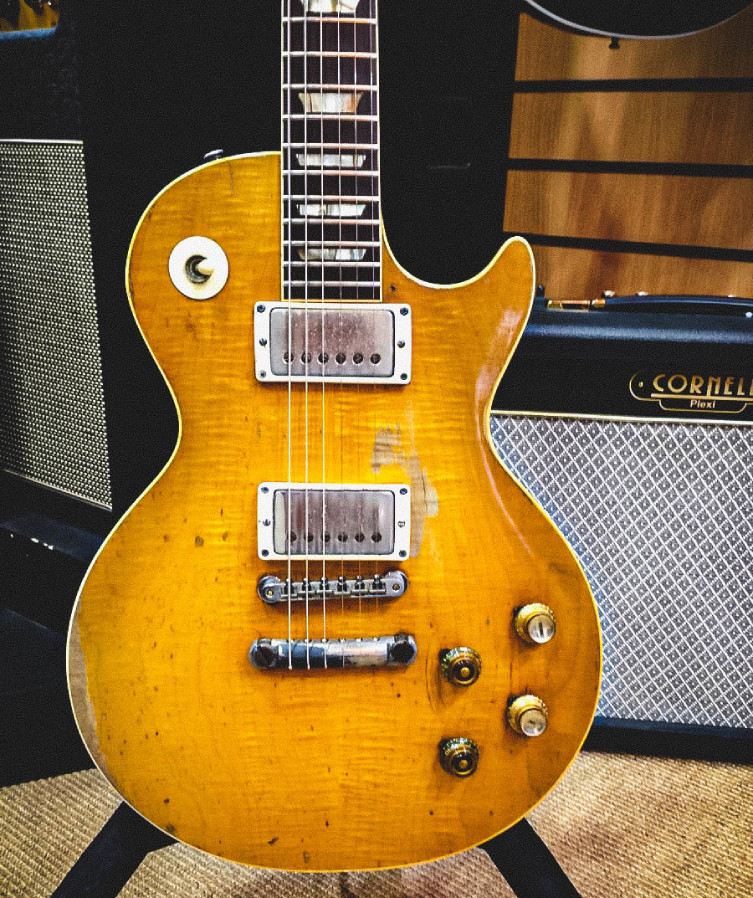 Peter Green playing the 'Greeny' Les Paul
Peter Green playing the 'Greeny' Les Paul
The saga of ‘Greeny’ extends far beyond its time with Peter Green. Known for his somewhat detached relationship with material possessions, Green famously sold the guitar to the late Gary Moore, the Irish blues-rock guitar virtuoso known for his work with Thin Lizzy and his formidable solo career, reportedly for a remarkably modest sum. Moore cherished and played ‘Greeny’ for decades, both in the studio and on stage, making it a central part of his signature sound before eventually retiring it from regular use. In a more recent chapter, Kirk Hammett of Metallica became the current custodian of ‘Greeny’, adding another layer to its legendary status. He continues to tour and record with this iconic instrument, surely incurring astronomical insurance premiums to safeguard this piece of guitar history.
Brian May’s Red Special: A Homemade Masterpiece of Innovation
Brian May of Queen is synonymous with a guitar tone as instantly recognizable and singular as his operatic guitar orchestrations. The genesis of this iconic sound is deeply intertwined with the very guitar he plays: the Red Special, an instrument he built himself with his father.
The tale is legendary and entirely true: the Mays, resourceful and innovative, utilized timber salvaged from an old fireplace, meticulously shaping and crafting the pieces to construct what would become one of the most famous electric guitars in existence. The Red Special, born from ingenuity and necessity, even featured a repurposed knitting needle as a whammy bar in its early iterations!
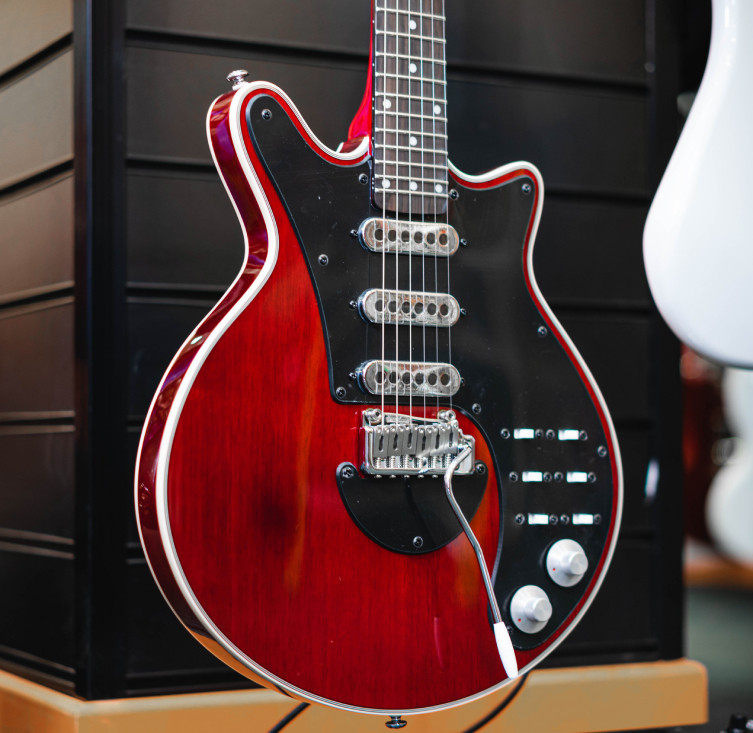 Brian May with his Red Special guitar
Brian May with his Red Special guitar
While the knitting needle may have been replaced over the Red Special’s impressive 50-plus years of service, Brian May’s unwavering dedication to this self-made instrument has remained constant throughout his illustrious career. Loaded with an array of custom switches and a set of Burns Tri-Sonic pickups (reportedly the only purchased components in the original build), the Red Special is the sonic engine behind every Queen album and has resonated in stadiums worldwide, contributing to some of the most iconic guitar riffs and solos in rock history.
Eddie Van Halen’s Frankenstein: The Superstrat Pioneer Forged in Innovation
Speaking of homemade guitars and groundbreaking playing styles, the Frankenstein, created by Eddie Van Halen, immediately springs to mind. While perhaps not entirely “built from scratch” like the Red Special, Eddie’s striped marvel was a revolutionary amalgamation of guitar parts, assembled to achieve a sound and playability unlike anything before. By bolting together components – a ‘Boogie Bodies’ Strat-style body (crafted by Wayne Charvel and later popularized by Dave Schecter) and a pre-existing Strat neck – Eddie birthed one of the most famous and visually distinctive guitars in rock history.
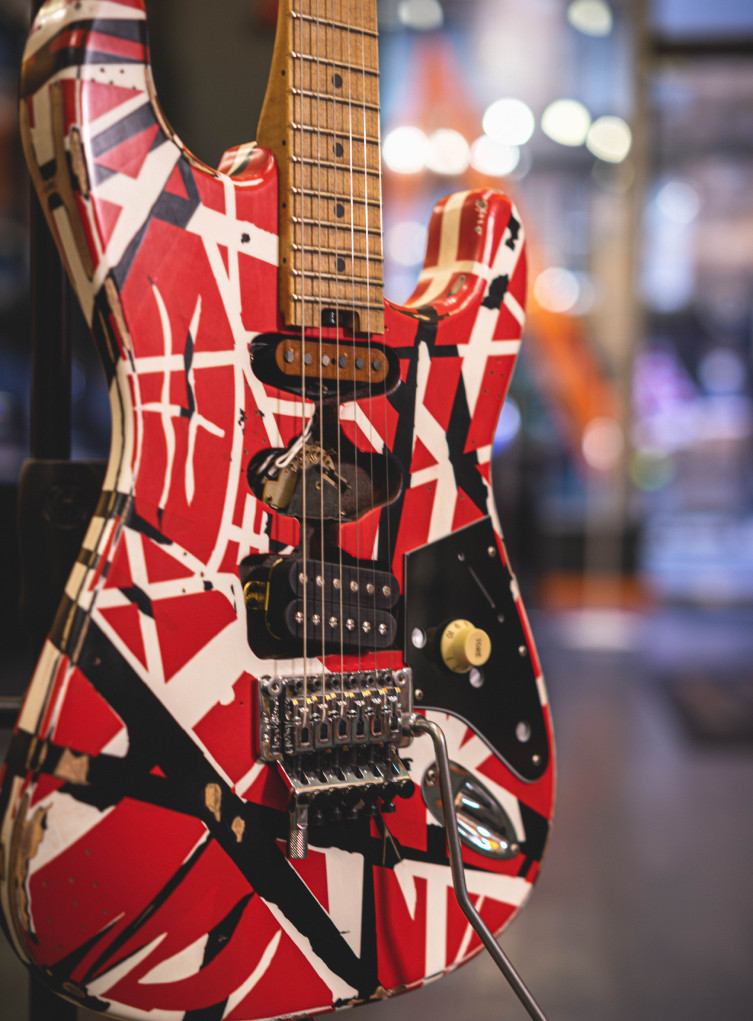 Eddie Van Halen playing his Frankenstein guitar
Eddie Van Halen playing his Frankenstein guitar
The Dutch-Californian guitar innovator, Eddie Van Halen, further customized his creation by transplanting an old PAF pickup scavenged from his Gibson ES-335. After physically routing out a cavity in the Strat body, he installed the humbucker, creating a powerful and unique tonal configuration. Inspired by Van Halen singer David Lee Roth, Eddie further personalized the instrument with masking tape and spray paint, resulting in the iconic striped finish that solidified the Frankenstein’s visual identity. This iconic guitar, often referred to as “Frankie”, became a symbol of Eddie’s innovative spirit.
This formula – a single humbucker-equipped Strat (the neck pickup was a non-functioning dummy) coupled with a tremolo bar – became the blueprint for the “Superstrat” guitar, dominating the 1980s guitar landscape and continuing to be a popular and influential guitar design to this day. Eddie Van Halen’s Frankenstein was not just a guitar; it was a catalyst for a new era in guitar design and playing.
Jimi Hendrix’s Monterey Strat: A Fiery Sacrifice at a Landmark Festival
Jimi Hendrix possessed a rare ability to imbue everything he touched with an aura of the extraordinary. Even a seemingly ordinary white Stratocaster, when wielded by Hendrix, transformed into “the Woodstock Strat,” a symbol of a generation. However, for this list, we highlight one of his more visually striking and frequently emulated instruments: the Monterey Strat.
 Jimi Hendrix performing with his Monterey Stratocaster
Jimi Hendrix performing with his Monterey Stratocaster
Like the Woodstock Strat, the Monterey Strat gained its moniker from the iconic music festival where it made its indelible mark: the 1967 Monterey Pop Festival in California. This Stratocaster is infamous for being the guitar Jimi dramatically “sacrificed” on stage, setting it ablaze in a climactic act of performance art. Interestingly, Hendrix primarily played a black Stratocaster for the majority of his Monterey set, switching to this hand-painted (with nail polish) white Stratocaster only for the final song, “Wild Thing,” and the legendary fiery finale.
While Jimi reportedly sustained minor burns from this performance, the Monterey Pop Festival performance and the iconic image of the burning Strat catapulted him to even greater fame and cemented his status as a rock icon. The Monterey Strat became a symbol of Hendrix’s revolutionary approach to music and performance, forever linking the guitar to a moment of rock history.
David Gilmour’s Black Strat: The Sound of Timeless Pink Floyd Albums
From one legendary Stratocaster to another, though thankfully this one has remained un-combusted! David Gilmour, the guitarist and co-vocalist of Pink Floyd, is globally recognized as one of the most influential and expressive guitarists of all time, particularly among Stratocaster devotees.
His primary instrument during the creation of groundbreaking albums such as Dark Side of the Moon, Wish You Were Here, and the Live at Pompeii concert film was a seemingly unassuming black Stratocaster. Over the years, Gilmour made only subtle modifications to this guitar, reflecting his preference for understated perfection. These alterations included a shortened tremolo arm, a mini-toggle switch (to engage the neck pickup in conjunction with other pickup selections), and a black single-ply pickguard.
These may seem like minor tweaks, but this black Stratocaster is undeniably one of the most heard and influential electric guitars in recorded music history. Its tones are woven into the fabric of some of the most beloved and enduring albums ever made, making it a cornerstone of rock guitar history.
Jimmy Page’s ‘Number One’ Les Paul: The Defining Sound of Led Zeppelin
For hard rock aficionados in the 1970s, few images were as captivating and inspiring as Jimmy Page, the guitar titan of Led Zeppelin, commanding the stage with his ‘Zoso’ adorned suit and his iconic ‘Number One’ Les Paul slung low. This image is etched into the collective memory of rock fans worldwide.
The guitar itself is another 1959 Les Paul Standard, acquired by Page from Eagles guitarist Joe Walsh in 1969. When Page took ownership, the guitar’s neck had already been reshaped to a thinner profile. Page further customized ‘Number One’ with a push-pull phase switch and, contrary to some persistent rumors, the pickups are indeed original, though the nickel covers have been removed, exposing the bobbins.
This instrument proved to be the perfect sonic weapon for the Led Zeppelin maestro, becoming his go-to guitar for countless iconic riffs, solos, and studio recordings. ‘Number One’ remains a vital part of Jimmy Page’s sound and legacy, continuing to be his main guitar to this day.
Stevie Ray Vaughan’s ‘Number One’ Stratocaster: The Soul of Texas Blues
Transitioning from one guitar icon’s ‘Number One’ to another, we arrive at the instantly recognizable Stratocaster of Stevie Ray Vaughan, a legend of Texas blues. Referred to as both ‘Number One’ and affectionately as his ‘First Wife’, this guitar is as integral to Vaughan’s sound as his fiery playing style. Stevie Ray Vaughan was a transformative figure in blues guitar, influencing countless players who followed in his wake. His untimely passing at the young age of 35 only amplified his legendary status, leaving behind a legacy of breathtaking blues guitar.
 Stevie Ray Vaughan playing his 'Number One' Stratocaster
Stevie Ray Vaughan playing his 'Number One' Stratocaster
Vaughan’s ‘Number One’ Stratocaster is itself a composite instrument, assembled from various Fender parts. The body is from a 1963 Stratocaster, the neck from a 1962, and the pickups are believed to be from 1959. Stevie added the distinctive black pickguard and a left-handed tremolo system. Remarkably, Vaughan himself stated that ‘Number One’ was “rebuilt more often than a custom Chevy“, testament to its constant use and modifications throughout his career.
Billy Gibbons’ Pearly Gates: The ZZ Top Legend with a Heavenly Tone
Staying in Texas, we turn our attention to another iconic guitarist and his legendary Les Paul: Billy F Gibbons of ZZ Top. Known for his impeccable tone, signature sunglasses, and larger-than-life persona, Gibbons is also the proud owner of ‘Pearly Gates’, completing the trinity of the most famous 1959 Les Pauls.
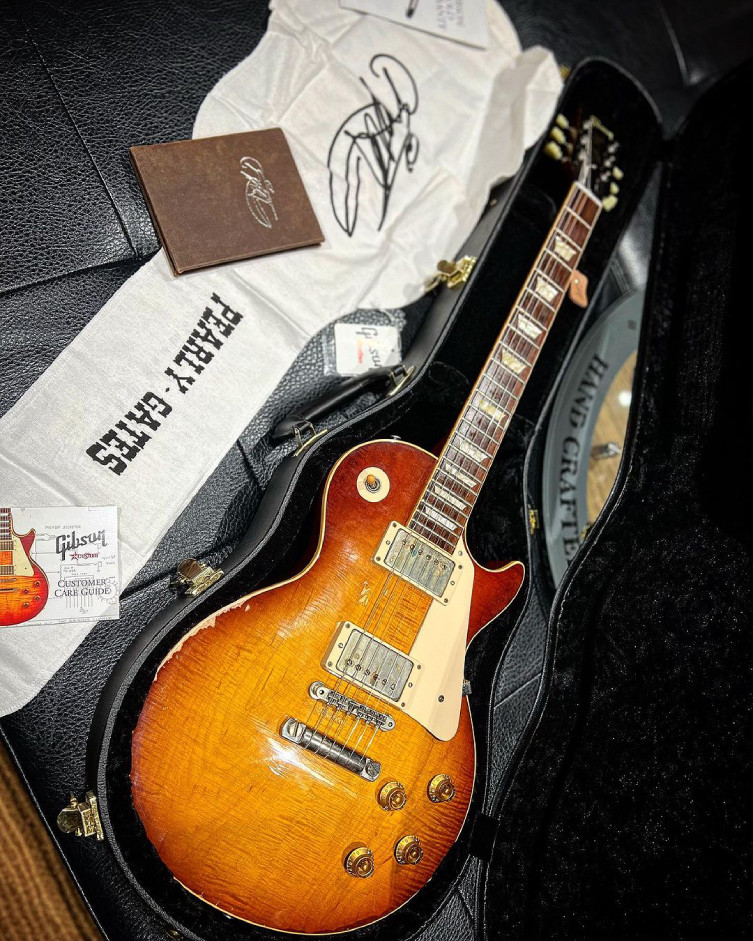 Billy Gibbons and his 'Pearly Gates' Les Paul
Billy Gibbons and his 'Pearly Gates' Les Paul
‘Pearly Gates’ is, indeed, another sunburst 1959 Les Paul Standard, and the captivating story of how Gibbons acquired it involves a Hollywood starlet, a Cadillac hearse, and a farmer who kept the guitar concealed under his bed. The full tale is a must-read for any guitar history enthusiast.
While Billy Gibbons is known to possess an extensive guitar collection that rivals the population of some small countries, ‘Pearly Gates’ remains the benchmark against which all his other tones are measured. Paired with his signature extra-light gauge 7 strings, a Mexican peso used as a guitar pick, and his trademark hats, ‘Pearly Gates’ is a crucial ingredient in the unique sonic gumbo that is the ZZ Top sound.
Steve Vai’s Evo: The Ibanez JEM and the Evolution of Shred
Steve Vai is a guitarist of extraordinary technical prowess and boundless creativity, demanding an instrument that could keep pace with his innovative playing style. Ibanez rose to the challenge in the 1980s when Vai approached various guitar companies about developing a signature model. Ibanez proved to be the perfect partner, successfully capturing both the essential elements Vai sought – feel and tone – and the unique, visually striking features that defined his artistic vision. The result was the Ibanez JEM, a guitar as distinctive and eccentric as its owner. Key features included the now-iconic “monkey grip” handle routed into the body, extensive tremolo cavity routing for extreme pitch manipulation, and the elaborate “tree-of-life” inlays adorning the entire fretboard.
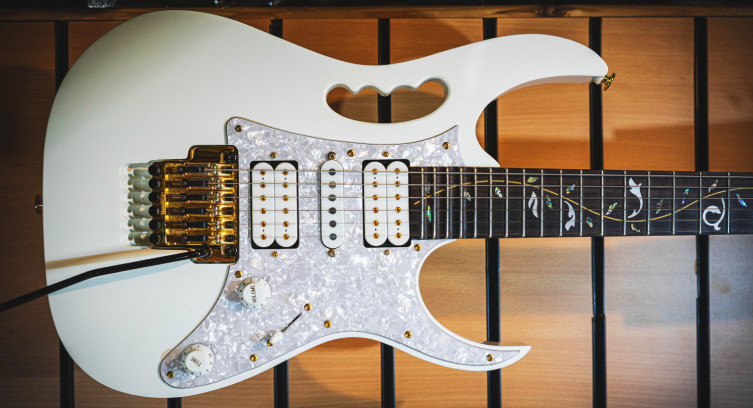 Steve Vai playing his Ibanez JEM "Evo" guitar
Steve Vai playing his Ibanez JEM "Evo" guitar
Vai’s personal favorite among the JEM prototypes he received from Ibanez is affectionately named “Evo” (short for Evolution, also the moniker he bestowed upon his signature DiMarzio pickups). Evo became the foundational blueprint for all subsequent Ibanez JEM models. It remains Steve Vai’s primary instrument for live performances and recordings, a testament to its enduring appeal and playability.
Many guitarists mistakenly assume the Ibanez JEM is a modified Ibanez RG model, but the reality is the opposite. The JEM, with its unique features and customizations for Vai, actually predates the simplified, mass-produced RG series. Ibanez streamlined the JEM design, removing elements like the monkey grip and vine inlays, to create the more commercially accessible RG line.
Tom Morello’s ‘Arm the Homeless’: Sonic Revolution and Political Statement
Rage Against the Machine has always fused potent political messages with their aggressive and innovative blend of rap and rock. Love songs are not on the Rage agenda; instead, expect a barrage of unconventional and groundbreaking sounds emanating from Tom Morello’s guitar. A true sonic innovator, Morello’s guitar vocabulary is among the most original and recognizable in contemporary music.
His ‘Arm the Homeless’ guitar is one of his primary instruments. Kept in standard E tuning due to its locking tremolo system, this guitar, along with a Fender American Standard Telecaster (tuned to drop-D), forms the core of Morello’s guitar work throughout Rage Against the Machine’s impactful career.
‘Arm the Homeless’ is another guitar with a history of constant modification and evolution. It has undergone over a dozen pickup swaps, four different necks, and multiple bridge replacements. In fact, the only original component remaining from the initial Performance Guitars USA instrument is the alder body.
‘Arm the Homeless’ features a Floyd Rose tremolo, a heavy-duty toggle switch (reportedly an “aircraft switch”), and EMG pickups. Intriguingly, the neck pickup is an EMG H, which is actually a single-coil pickup housed in a humbucker casing. Regarding the guitar’s provocative name and assortment of stickers, Tom Morello explains: “We were set to play at the Whisky a Go-Go and, just before going over to soundcheck, I scrawled ‘Arm the Homeless’ on the guitar. I liked the juxtaposition of that kind of provocative and militant situationist slogan with those four smiling hippopotamuses all facing in one direction.“
Famous Guitars, Lasting Legacies
Beyond this list, countless other famous guitar and artist pairings come to mind. Eric Clapton’s ‘The Fool’ SG, Buddy Guy’s polka dot Stratocaster, Billy Duffy’s White Falcon – the connections between certain guitars and specific musicians are deeply ingrained in music history and fan culture. The enduring nature of these associations is truly remarkable.
It’s noteworthy that this list includes no fewer than three different 1959 Les Pauls, each deserving of its iconic status. Another recurring theme is the significant modifications and alterations many of these famous guitars have undergone. At least four of these ten instruments have been extensively modified or pieced together (one even built entirely from scratch), while another five have been altered to varying degrees. Only ‘Pearly Gates’, to our knowledge, remains largely in its original factory condition.
This pattern suggests that these exceptional musicians often felt compelled to adapt their instruments to their individual playing styles and sonic visions. The “stock” configuration was simply not enough to fully express their unique musical voice. This drive for personalization underscores a crucial lesson for aspiring musicians: draw inspiration from these legendary players, but ultimately forge your own path. Experiment, modify, and customize your gear to discover your own unique sound. Don’t merely imitate; innovate and be yourself.
However, if you happen to own a genuine, pristine 1959 Les Paul Standard, perhaps reconsider any drastic modifications. Just a thought!

